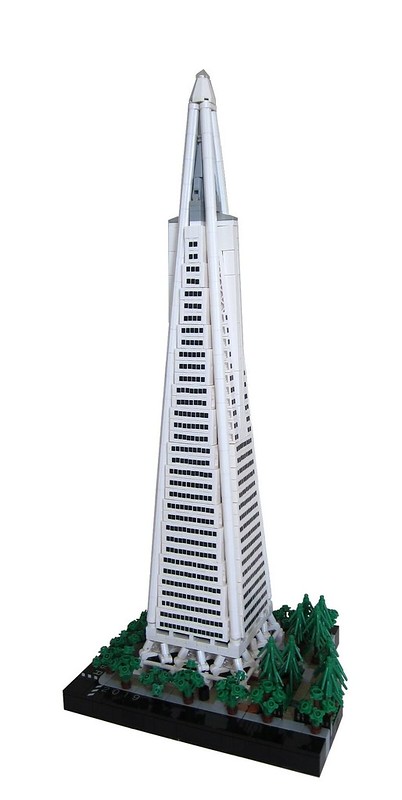Since 2002, Spencer_R has been wanting to build the Transamerica Pyramid in San Francisco. One key thing held them back; they were stymied by the lack of the perfect part. (A feeling that is familar to many LEGO builders, I’m sure.) Flash forward to 2017 and the release of the 1×1 plate with a printed square pattern, part of the 70620 Ninjago City set. Then flash forward another year or two, as Spencer needed a whopping 1040 of them to complete the build. The end result is 1/650th scale version that is both a labor of love and a treat for the eyes.
Beyond the highly accurate recreation of the shape of the tower, Spencer has also faithfully reproduced many other details. At the base of the tower the park contains redwood trees made from flower stems, a fence of 1×2 grilled tiles, and a 1×1 round plate standing in for the fountain. There’s even a cafe pavilion overlooking the park grounds.
Be sure to check out the full album on flickr for even more close up details, build commentary, and a great overview of the history and features of the real building.


Nice build, but I have to ask – if the tiles are printed, why are they seemingly very inconsistently positioned? Is Lego QC that bad that the printing isn’t consistent across batches these days?
I just saw it in person today at our MichLUG meeting.
@RichardP:
He actually talked about that very thing with another of our members. The print was apparently so inconsistently placed on these parts that it took a lot of trial and error to get them to line up _this_ good. My take on it is that, ironically, they do a better job of printing in China than in the EU. I remember my very first Boba Fett minifig from the first Slave I set had cockeyed print on the brow of his helmet. There are two little triangles there, and they looked like someone had tripped and fallen against the printing machine right as it was stamping those triangles. I’ve got another one sitting by my TV where the triangles are at least level, but they’re still noticeably off to one side compared to the T-slot visor. Compare that to Chinese-made CMFs, where not one single person appears to have complained that the eyes didn’t match up with the S3 Gorilla Suit eyeholes. I mean, I specifically remember being worried about how bad that was going to turn out, but when I actually got my hands on some they were always dead on. I still find a lot of dual-sided heads where the two faces are not printed exactly 180 degrees from each other, but the CMF print has always been really good. My theory on this is that the Chinese facilities are all new enough that they got more modern equipment, while the EU facilities may be using stuff that’s decades old at this point.
PD is correct. In my first building attempt, I just randomly assembled the columns of 1×1 side-printed elements and found the black “windows” were just as randomly centered all over the place. So took it all apart and roughly batch-sorted them visually into off-left, centered, and off-right categories. Then I built a bunch of individual columns from each of these three bins, trying to match up off-top, centered, and off-bottom elements as best I could to keep the spacing somewhat consistent. It was an extremely tedious process and it’s certainly far from perfect, but was a big improvement from where I started.